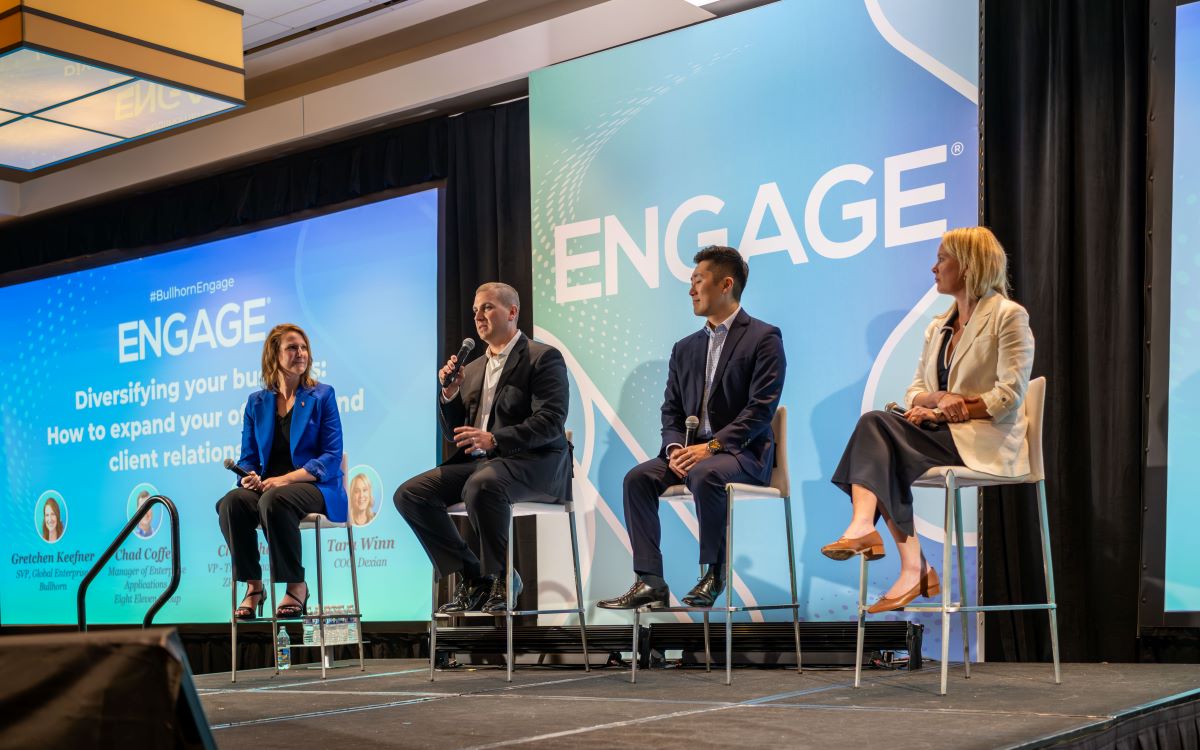Take a look at the quarterly reports of any public staffing firm at the moment, and you’re sure to find a full readout of how that firm is diversifying, whether in their product line, service line, verticals, or geography. Diversifying isn’t just a hot topic in the industry—it’s survival.
At our recent Engage Boston, we gathered some of the industry’s key players for a candid conversation about their experiences—the high points and the low. The result is a series of takeaways our larger network can benefit from, including tips and tools you can incorporate today.
Read on for insights from:
- Gretchen Keefner, SVP, Global Enterprise, Bullhorn
- Chad Coffey, Manager of Enterprise, Eight Eleven Group
- Chris Choe, VP – Transformations, ZRG
- Tara Winn, COO, Dexian
Accommodate growth with the right tech stack
Traditionally an executive search firm, ZRG diversified into the interim fractional space about five years ago, growing from a $40 million business to $250 million in the process. During this process, the company outgrew their previous platform, as it wasn’t best suited to accommodate their acquisition of consulting, interim and RPO business.
Suddenly, the business had a bottleneck. Having acquired 13 companies and nine different systems, “we were very fragmented,” shared Choe. “Everybody was working out of their own little systems as divisions.” They realized that as they were nearing the $200 million milestone, they’d have to pivot their tech strategy.
They ultimately landed on Salesforce, due to the embedded knowledge of Bullhorn, married with growth opportunity like product building for the recruiting business. “Ensure that tech stack design is a part of your strategic planning, and that you have a tech stack that enables agility,” added Keefner.
Do no harm
Dexian, a core staff augmentation business that recruits, develops, and nurtures global talent, has undergone seven M&As in the past seven years. In order to navigate this pace of growth, they’ve developed a “do no harm” policy when it comes to these integrations.
“When we move into a new product line or we have a new business that we’re trying to fold in,” shared Winn, “it’s important as a people-first company that we immediately assess talent, but we also put resources in place to protect revenue.” Organizationally, “do no harm” means prioritizing both clients and colleagues, while also protecting both people and revenue at all costs. “By leaning in and being more collaborative with our partnerships and our relationships, we really hear what our customers are looking for,” said Winn.
It also allows them to make decisions fast and maintain agility while augmenting their capabilities with a unique platform of services. “If we see an opportunity that matches our core services, the financials check out, and we have the ability to execute, we’ll move after it pretty quickly and buy—but at the same time, buying takes power,” shared Winn.
Communication is key—but ask for help
For an organization that maintains a nimble state of adapting and being flexible both operationally and culturally, the fast pace of acquisition at ZRG has surfaced some challenges when it comes to communicating both internally and externally.
“There are frictions as new companies of different sizes are being acquired,” Choe said, leading to stakeholders asking themselves, What are our core values? What needs to stay, and what needs to go? The game-changer at ZRG was when they sought external support from a brand firm that specialized in strategic communications.
“They did a fantastic job of outlining exactly what our model was for the absorption of these brands. This has helped not just externally, but internally the team understands how we’re going to be approaching these brands that we are acquiring, because that was one of the biggest struggles that we had, as we were growing so rapidly.” The company adopted new terminology, rather than internal players referring to each other by legacy names, which helped the fusion of a new, integrated organization.
Your customer is talking to you—listen
After Dexian went through their merger and acquisition, “it was very clear to us about a year into it that we had to have a new a new brand, a new name, a new flag, if you will,” shared Winn. The company’s CMO Kit Pavel led a two-year process of realizing that new flag, which started with a meaningful dialog with the company’s customers.
“We learned how they perceived us as the legacy brands and then what they really wanted from us, as Dexian,” shared Winn. “Through those conversations, which weren’t linear, we were able to have a different seat at the table, which ultimately led us into a very trusting relationship with our customers. Now they’re telling us exactly what they do want and we’re operating in a new world of business.”
The result is a truly collaborative partnership that has opened up the company’s diversification strategy. Said Winn, “it was the voice of the customer work that allowed us to have those conversations. We weren’t just getting requirements anymore.”
Embrace the customer perspective first
“Take the time to listen to your customers, ask them what they want, and then move in whichever pace you’re able to,” said Winn. The panel urged leaders to adopt a clear vision from the top down, not just internally, but also in terms of client expectations. By supplementing that vision with the right talent and having the hard conversations about whether the organization has the talent to support that end goal, tough conversations can realize better outcomes for all.
For more business insights, check out the Engage Boston Content Hub.





